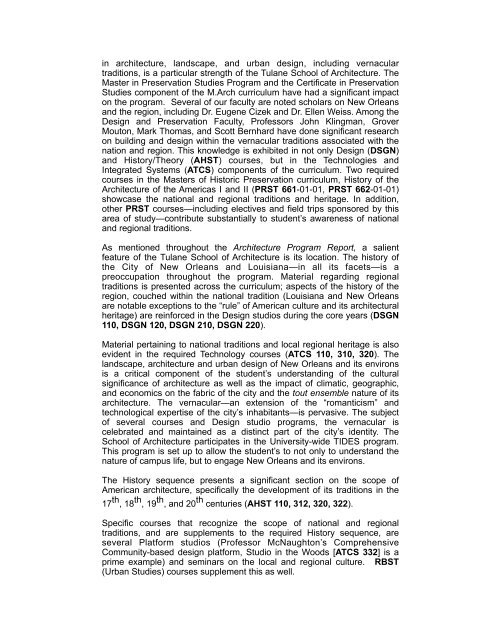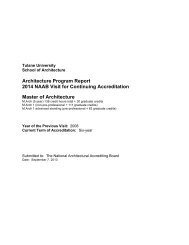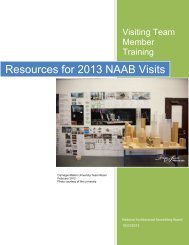Architecture Program Report Tulane University New Orleans ...
Architecture Program Report Tulane University New Orleans ...
Architecture Program Report Tulane University New Orleans ...
You also want an ePaper? Increase the reach of your titles
YUMPU automatically turns print PDFs into web optimized ePapers that Google loves.
in architecture, landscape, and urban design, including vernacular<br />
traditions, is a particular strength of the <strong>Tulane</strong> School of <strong>Architecture</strong>. The<br />
Master in Preservation Studies <strong>Program</strong> and the Certificate in Preservation<br />
Studies component of the M.Arch curriculum have had a significant impact<br />
on the program. Several of our faculty are noted scholars on <strong>New</strong> <strong>Orleans</strong><br />
and the region, including Dr. Eugene Cizek and Dr. Ellen Weiss. Among the<br />
Design and Preservation Faculty, Professors John Klingman, Grover<br />
Mouton, Mark Thomas, and Scott Bernhard have done significant research<br />
on building and design within the vernacular traditions associated with the<br />
nation and region. This knowledge is exhibited in not only Design (DSGN)<br />
and History/Theory (AHST) courses, but in the Technologies and<br />
Integrated Systems (ATCS) components of the curriculum. Two required<br />
courses in the Masters of Historic Preservation curriculum, History of the<br />
<strong>Architecture</strong> of the Americas I and II (PRST 661-01-01, PRST 662-01-01)<br />
showcase the national and regional traditions and heritage. In addition,<br />
other PRST courses—including electives and field trips sponsored by this<br />
area of study—contribute substantially to student’s awareness of national<br />
and regional traditions.<br />
As mentioned throughout the <strong>Architecture</strong> <strong>Program</strong> <strong>Report</strong>, a salient<br />
feature of the <strong>Tulane</strong> School of <strong>Architecture</strong> is its location. The history of<br />
the City of <strong>New</strong> <strong>Orleans</strong> and Louisiana—in all its facets—is a<br />
preoccupation throughout the program. Material regarding regional<br />
traditions is presented across the curriculum; aspects of the history of the<br />
region, couched within the national tradition (Louisiana and <strong>New</strong> <strong>Orleans</strong><br />
are notable exceptions to the “rule” of American culture and its architectural<br />
heritage) are reinforced in the Design studios during the core years (DSGN<br />
110, DSGN 120, DSGN 210, DSGN 220).<br />
Material pertaining to national traditions and local regional heritage is also<br />
evident in the required Technology courses (ATCS 110, 310, 320). The<br />
landscape, architecture and urban design of <strong>New</strong> <strong>Orleans</strong> and its environs<br />
is a critical component of the student’s understanding of the cultural<br />
significance of architecture as well as the impact of climatic, geographic,<br />
and economics on the fabric of the city and the tout ensemble nature of its<br />
architecture. The vernacular—an extension of the “romanticism” and<br />
technological expertise of the city’s inhabitants—is pervasive. The subject<br />
of several courses and Design studio programs, the vernacular is<br />
celebrated and maintained as a distinct part of the city’s identity. The<br />
School of <strong>Architecture</strong> participates in the <strong>University</strong>-wide TIDES program.<br />
This program is set up to allow the student’s to not only to understand the<br />
nature of campus life, but to engage <strong>New</strong> <strong>Orleans</strong> and its environs.<br />
The History sequence presents a significant section on the scope of<br />
American architecture, specifically the development of its traditions in the<br />
17 th , 18 th , 19 th , and 20 th centuries (AHST 110, 312, 320, 322).<br />
Specific courses that recognize the scope of national and regional<br />
traditions, and are supplements to the required History sequence, are<br />
several Platform studios (Professor McNaughton’s Comprehensive<br />
Community-based design platform, Studio in the Woods [ATCS 332] is a<br />
prime example) and seminars on the local and regional culture. RBST<br />
(Urban Studies) courses supplement this as well.














